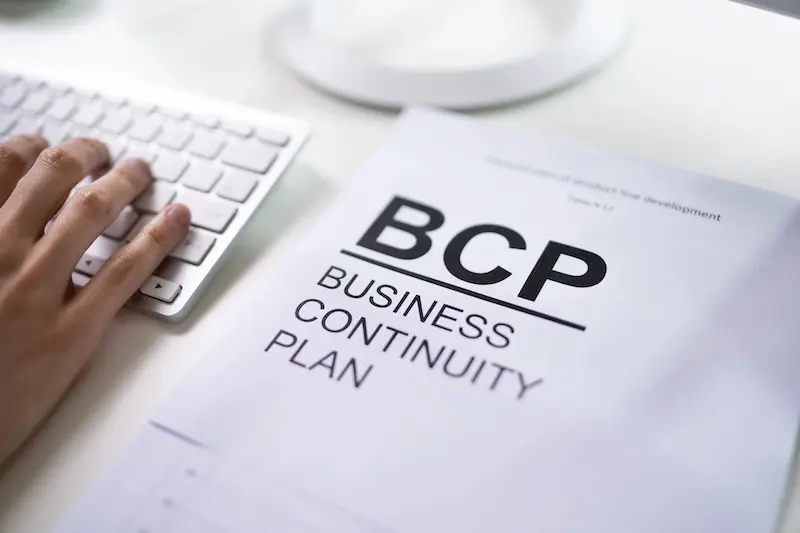The modern world of work was massively reshaped by the global COVID crisis, but arguably the biggest lesson it has instilled in Irish organisations is the importance of business continuity planning (BCP).
That said, it’s important to note that the necessity for BCP goes beyond unprecedented events like the aforementioned pandemic, extending to extreme weather catastrophes, cyberattacks and hardware failures.
With SMEs in this country facing a growing range of risks, the stakes have never been higher. Preparation is key to ensuring your business remains resilient in the face of any of these incidents, which is what business continuity planning is all about.
Read on to discover our practical, step-by-step guide to secure your business’s future through a thorough and proactive BCP.
The core function of business continuity planning
At its essence, BCP has one primary function: to ensure your organisation can continue or resume essential operations during and after an unforeseen disruption. In the case of SMEs, BCP is vital for several reasons:
- Unplanned downtime can have real financial consequences – particularly for SMEs, who experience, on average, around 14 hours of downtime annually.
- SMEs are highly vulnerable to cybercrime – a leading cause of downtime – with almost three-quarters of Irish businesses reporting an increase in cyberattacks in 2024.
- Aside from the financial implications, such disruptions can also damage reputation and customer trust, leading to negative long-term effects on a business.
Business continuity planning represents a proactive route towards protecting your business’s reputation, along with your bottom line.
What is the difference between business continuity planning and disaster recovery?
The main difference between these two entities is that business continuity planning is broader than just disaster recovery, as it includes all routine and major interruptions, not just IT failures.
BCP keeps the whole business moving in the event of downtime, while disaster recovery ensures that your business’s core systems and data are restored without any major negative ramifications.
What are the steps involved in creating a solid business continuity planning strategy?
Building a reliable BCP strategy can be achieved in a six-step process:
#1. Identify your business’s critical activities
To create an actionable plan, you must first identify how vulnerable your business is to downtime.
This can be achieved by pinpointing the functions that are integral to the continuation of your operations, along with the people, suppliers and systems that support these functions.
Doing this will help you to define the baseline for downtime impacts and guide how much disruption your business can tolerate.
#2. Create an incident response plan
This phase revolves around building a plan that details step-by-step actions to follow during an incident.
The foundations of this plan should include key information, such as the individual roles and responsibilities of each team member.
It should also include response processes, which must be consistently reviewed and easily accessible.
#3. Develop strong backup and disaster recovery systems
To promote prompt recovery from downtime, every SME should implement thorough backup and disaster recovery systems by:
- Using managed cloud backup and recovery features, which ensure your data is automatically backed up, encrypted and monitored around the clock.
- Mixing onsite and cloud backups – the former to facilitate fast recovery from small hiccups, and the latter to protect you if your office systems fall victim to fire, flood, cyberattack or any other disaster.
- Allowing your RPO and RTO to inform your backup and recovery set-up.
Each of the above will lend itself to a system that works for your business’s individual needs.
#4. Implement a failover and continuity framework
This is a vital step to influence a speedy response.
It can be achieved first and foremost by using cloud-based failover systems to move operations quickly in case of hardware or system failure. Bolstering remote access routes for distributed teams to facilitate continued connection during disruptions will further support continuity efforts.
Enlisting recovery training from an IT solutions provider is also advisable, to empower both management and on-the-ground teams to react effectively if continuity is compromised.
#5. Conduct routine testing to trial the efficacy of your business continuity planning strategy
Routine testing is hugely important to ensure all backup and recovery processes work as intended during an unplanned disruption. This should include conducting regular team drills to verify that employees know how to respond in the moment, and to mitigate the onset of panic if a real-life incident were to occur.
Continuous monitoring should also form a significant part of your test-drill strategy, as detecting inconsistencies early will enable you to address issues before they escalate.
#6. Partner with a trusted IT provider
Working with a certified IT partner significantly assists with the creation of a BCP strategy and will give you the peace of mind that the plan is reliable and backed by expertise.
What’s more, availing of this service for your business means you can avail of proactive monitoring, maintenance, cybersecurity and tailored continuity planning to suit your business needs.
Simplify your business continuity planning with the help of Calnet IT Solutions
At Calnet IT, we have over 25 years of experience supporting Irish businesses. This is the reason SMEs continue to turn to us for reliable business continuity planning.
From fully managed cloud backup and disaster recovery to 24/7 monitoring, we deliver secure, compliant and stress-free protection for your business.
Our local team combines technical expertise with a hands-on approach, ensuring your systems, data, and people are ready for anything.
If you want peace of mind that your business can keep moving no matter what, contact us today.






